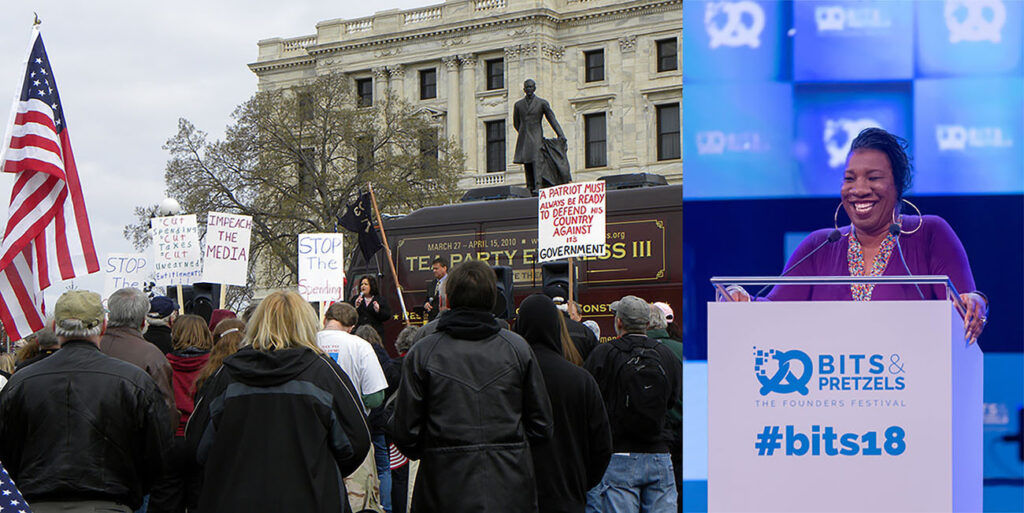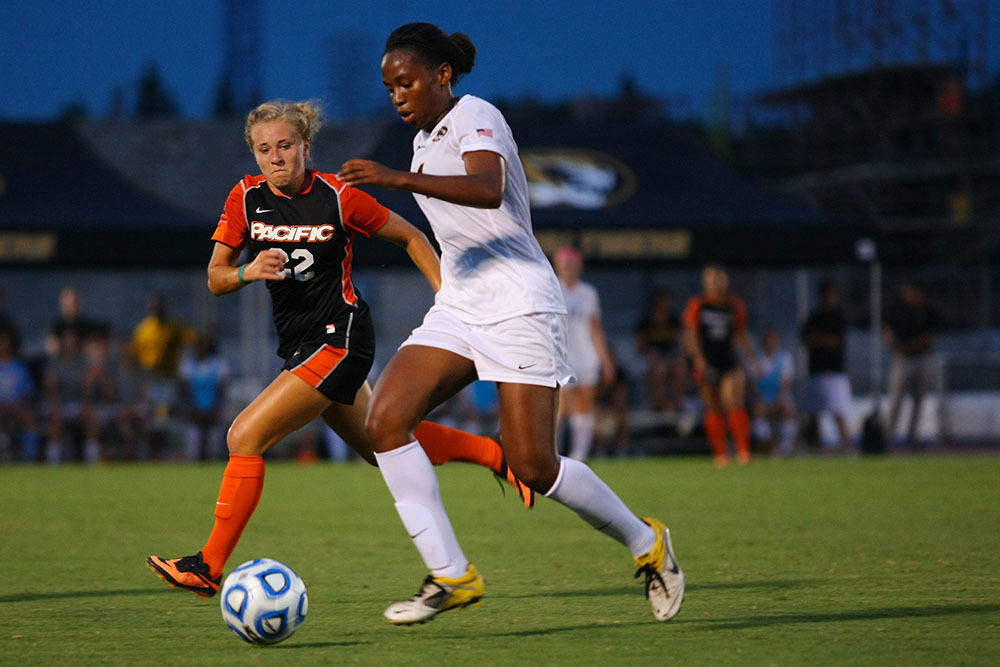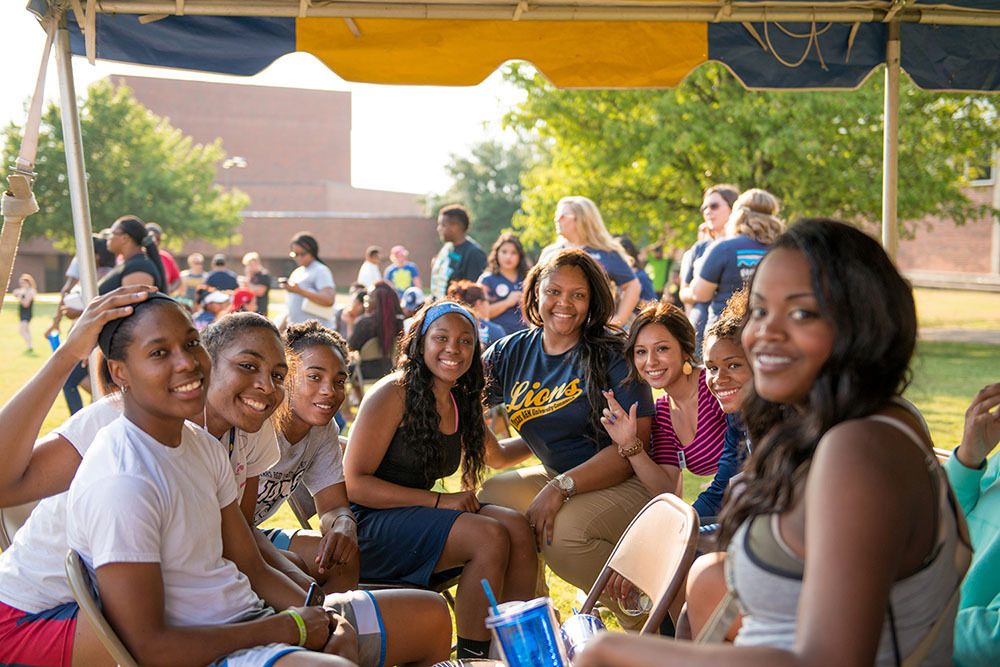
Figure 6.1 The national tour of the Tea Party Express visited Minnesota and held a rally outside the state capitol building. Tarana Burke, who originated the term “me too” in the context of supporting or acknowledging sexual harassment or assault victims, has spoken frequently on the evolution and issues regarding the MeToo movement. (Credit: a. Fibonacci Blue/flickr; b Marco Verch)
Groups and Organization
Chapter Outline
- 6.1 Types of Groups
- 6.2 Group Size and Structure
- 6.3 Formal Organizations
Throughout the history of the United States, individuals have formed groups in order to achieve goals and bring about change. Some groups are loosely defined, while others have highly organized structure and mission. And in some cases, groups can have significant influence on culture, society, the economy, and government.
In 2009, people protesting government spending held a series of “tea parties,” referencing the Boston Tea Party, an anti-taxation event that led up to the Revolutionary War. Tea Party activists also opposed big government, high taxes, and political corruption and supported gun rights and traditional family values. They called for “awareness to any issue which challenges the security, sovereignty, or domestic tranquility of our beloved nation, the United States of America” (Tea Party, Inc. 2021). The movement grew into a major political force, with chapters popping up in nearly every community across the country.
By 2010, Tea Party candidates had won seats in the U.S. House of Representatives and the Senate, demonstrating the political power of the group and its message. As grassroots activism faded, the Tea Party gained influence within the Republican Party. Many of its ideas have been assimilated into the mainstream conservative movement and Republican Party platform.
In 2016, highly successful Fox News host Gretchen Carlson filed a lawsuit against Fox chairman, Roger Ailes, for sexual harassment. The suit led other women to come forward with similar allegations against Ailes and others in the entertainment industry. Soon after, actress Alyssa Milano posted this statement on Twitter: “If all the women who have been sexually harassed or assaulted wrote ‘Me too’ as a status, we might give people a sense of the magnitude of the problem.” The phrase, “Me Too” had been first used in this context in 2006 by activist Tarana Burke, in an effort to empower women of color. Within a day of Milano’s post, the “Me Too” phrase or hashtag was used over 500,000 times on Twitter, and was used in over 12 million posts by 4.7 million people on Facebook. Thousands of people, including other celebrities, shared their own stories of sexual harassment, abuse, or assault. (MeTooMvmt.org, 2020) The “MeToo” movement became the lead story on many newscasts and talk shows. Over the months that followed, the movement sparked reforms within companies and governments to combat sexual harassment and better support women. The movement inspired abuse victims to come forward and led to the sanction or removal of prominent individuals accused of serial harassment or abuse in academia, media, government, and other industries.
The Tea Party evolved into an organization. From a loosely associated set of local chapters, it developed into several closely affiliated nonprofits (filed with the IRS), a political faction within the Republican Party, and a caucus within Congress. What about the MeToo movement? Burke started it in 2006 and was working to enact change long before the hashtag sparked more awareness and new policies. The MeToo has brought together people to work in groups, but it has yet to form into a permanent MeToo organization.
As enduring social units, groups help foster shared value systems and are key to the structure of society as we know it. There are three primary sociological perspectives for studying groups: Functionalist, Conflict, and Interactionist. We can look at the Tea Party and the MeToo movements through the lenses of these methods to better understand the roles and challenges that they offer.
The Functionalist perspective is a big-picture, macro-level view that looks at how different aspects of society are intertwined. This perspective is based on the idea that society is a well-balanced system with all parts necessary to the whole, and it studies the roles these parts play in relation to the whole. A Functionalist might look at the macro-level needs that each movement serves. For example, a Structural Functionalist might ask how the Tea Party arose to voice the concerns of a large sector of society that felt politically underrepresented, or how MeToo drove people to pay attention to sexual harassment and gender inequality. This approach might look at how each group enabled the voicing of discontent and so stabilized society.
The Conflict perspective is another macroanalytical view, one that focuses on the genesis and growth of inequality. A conflict theorist studying the Tea Party Movement might look at how it checked interests that have manipulated the political system over the last 30 years. Or this perspective might explore how MeToo challenged organizations that have allowed sexual harassment to persist in order to protect those in power.
A third perspective is the Symbolic Interaction or Interactionist perspective. This method of analyzing groups takes a micro-level view. Instead of studying the big picture, these researchers look at the day-to-day interactions of groups. Studying these details, the Interactionist looks at issues like leadership style and group dynamics. In the case of the Tea Party Movement, Interactionists might ask, “How does the Tea Party dynamic in New York differ from that in Atlanta?” Or, in the case of the MeToo, researchers may seek to learn about who defines the agenda and approach within the movement.
Types of Groups
Learning Objectives
By the end of this section, you should be able to:
- Differentiate between primary and secondary groups.
- Recognize in-groups and out-groups as subtypes of primary and secondary groups
- Define reference groups
Most of us feel comfortable using the word “group” without giving it much thought. Often, we mean different things when using that word. We might say that a group of kids all saw the dog, and it could mean 250 students in a lecture hall or four siblings playing on a front lawn. In everyday use, it can be a generic term, although it carries important clinical and scientific meanings. Moreover, the concept of a group is central to much of how we think about society and human interaction. So how can we hone the meaning more precisely for sociological purposes?
Defining a Group
The term group is an amorphous one and can refer to a wide variety of gatherings, from just two people (think about a “group project” in school when you partner with another student), a club, a regular gathering of friends, or people who work together or share a hobby. In short, the term refers to any collection of at least two people who interact with some frequency and who share a sense that their identity is somehow aligned with the group. Of course, every time people are gathered, it is not necessarily a group. A rally is usually a one-time event, for instance, and belonging to a political party doesn’t imply interaction with others. People who happen to be in the same place at the same time but who do not interact or share a sense of identity—such as a bunch of people standing in line at Starbucks—are considered an aggregate, or a crowd.
Another example of a nongroup is people who share similar characteristics but are not tied to one another in any way. These people are considered a category, and as an example all children born from approximately 1980–2000 are referred to as “Millennials.” Why are Millennials a category and not a group? Because while some of them may share a sense of identity, they do not, as a whole, interact frequently with each other.
Interestingly, people within an aggregate or category can become a group. During disasters, people in a neighborhood (an aggregate) who did not know each other might become friendly and depend on each other at the local shelter. After the disaster when people go back to simply living near each other, the feeling of cohesiveness may last since they have all shared an experience. They might remain a group, practicing emergency readiness, coordinating supplies for next time, or taking turns caring for neighbors who need extra help.
Similarly, there may be many groups within a single category. Consider teachers, for example. Within this category, groups may exist like teachers’ unions, teachers who coach, or staff members who are involved with the PTA.
Types of Groups
Sociologist Charles Horton Cooley (1864–1929) suggested that groups can broadly be divided into two categories: primary groups and secondary groups (Cooley 1909). According to Cooley, primary groups play the most critical role in our lives. The primary group is usually fairly small and is made up of individuals who generally engage face-to-face in long-term emotional ways. This group serves emotional needs: expressive functions rather than pragmatic ones. The primary group is usually made up of significant others, those individuals who have the most impact on our socialization. The best example of a primary group is the family.
Secondary groups are often larger and impersonal. They may also be task-focused and time-limited. These groups serve an instrumental function rather than an expressive one, meaning that their role is more goal- or task-oriented than emotional. A classroom or office can be an example of a secondary group.
Neither primary nor secondary groups are bound by strict definitions or set limits. In fact, people can move from one group to another. A group of coworkers, for example, can start as a secondary group, but as the employees work together over the years, they may find common interests and strong ties that transform them into a primary group. As we will discuss in the chapter on Media and Technology, even online networks of people with common interests can sometimes move from secondary to primary group status.
SOCIOLOGY IN THE REAL WORLD
Best Friends She’s Never Met
Writer Allison Levy worked alone. While she liked the freedom and flexibility of working from home, she sometimes missed having a community of coworkers, both for the practical purpose of brainstorming and socializing. Levy did what many do in the Internet age: she found a group of other writers online through a web forum. Over time, a group of approximately twenty writers, who all wrote for a similar audience, broke off from the larger group and started a private invitation-only forum. While writers in general represent all genders, ages, and interests, this group ended up being a collection of twenty- and thirty-something women who all wrote fiction for children and young adults.
At first, the writers’ forum was clearly a secondary group united by the members’ professions and work situations. As Levy explained, “On the Internet, you can be present or absent as often as you want. No one is expecting you to show up.” It was a useful place to research information about publishers, recently-published books and authors, and industry trends. But as time passed, Levy found it served a different purpose. Since the group shared other characteristics beyond their writing (such as age and gender), their conversation naturally turned to matters such as child-rearing, aging parents, health, and exercise. Levy found it was a sympathetic place to talk about any number of subjects, not just writing. Further, when people didn’t post for several days, others expressed concern, asking whether anyone had heard from the missing writers. It reached a point where most members would tell the group if they were traveling or needed to be offline for awhile.
The group continued to share. One member on the site who was going through a difficult family illness wrote, “I don’t know where I’d be without you women. It is so great to have a place to vent that I know isn’t hurting anyone.” Others shared similar sentiments.
So is this a primary group? Most of these people have never met each other. They live in Hawaii, Australia, Minnesota, and across the world. They may never meet. Levy wrote recently to the group, saying, “Most of my ‘real-life’ friends and even my husband don’t really get the writing thing. I don’t know what I’d do without you.” Despite the distance and the lack of physical contact, the group clearly fills an expressive need.

Figure 6.2 Engineering and construction students gather around a job site. How do your academic interests define your in- and out-groups? (Credit: USACEpublicaffairs/flickr)
In-Groups and Out-Groups
One of the ways that groups can be powerful is through inclusion, and its inverse, exclusion. The feeling that we belong in an elite or select group is a heady one, while the feeling of not being allowed in, or of being in competition with a group, can be motivating in a different way. Sociologist William Sumner (1840–1910) developed the concepts of in-group and out-group to explain this phenomenon (Sumner 1906). In short, an in-group is the group that an individual feels she belongs to, and she believes it to be an integral part of who she is. An out-group, conversely, is a group someone doesn’t belong to; often we may feel disdain or competition in relationship to an out-group. Sports teams, unions, and sororities are examples of in-groups and out-groups. Primary groups consist of both in-groups and out-groups, as do secondary groups.
While group affiliations can be neutral or positive, the concept of in-groups and out-groups can also explain some negative human behavior, such as white supremacist movements. By defining others as “not like us” and inferior, in-groups can end up practicing ethnocentrism, racism, sexism, ageism, and heterosexism—manners of judging others negatively based on their culture, race, sex, age, or sexuality.
Often, in-groups can form within a secondary group. For instance, a workplace can have cliques of people, from senior executives who play golf together, to engineers who write code together, to young singles who socialize after hours. While these in-groups might show favoritism and affinity for other in-group members, the overall organization may be unable or unwilling to acknowledge it. Therefore, it pays to be wary of the politics of in-groups, since members may exclude others as a form of gaining status within the group.
BIG PICTURE
Bullying and Cyberbullying: How Technology Has Changed the Game
Most of us know that the old rhyme “sticks and stones may break my bones, but words will never hurt me” is inaccurate. Words can hurt, and never is that more apparent than in instances of bullying. Bullying often reaches extreme levels of cruelty in children and young adults. People at these stages of life are especially vulnerable to opinions of others and deeply invested in their peer groups. Today, cyberbullying is on the rise. Cyberbullying can involve sending threatening texts, harassing someone in a public forum (such as social media), hacking someone’s account and pretending to be them, posting embarrassing images online, and so on. A study by the Cyberbullying Research Center found that 28 percent of teens have been a victim of cyberbullying (Hinduja and Patchin, 2019). Severe bullying can lead to suicidal thoughts and suicide attempts (John, 2018). Researchers noted that students who experienced in-person and online bullying were eleven times more likely to attempt suicide (Hinduja, 2018). Whereas bullying face-to-face requires willingness to interact with your victim, cyberbullying allows bullies to harass others from the privacy of their homes without witnessing the damage firsthand. This form of bullying is particularly dangerous because it’s widely accessible and therefore easier to carry out. Cyberbullying can create a feeling of powerlessness and inescapability because victimization is not constrained to physical locations. Many victims report being harassed across multiple platforms or formats at the same time.
Cyberbullying first made international headlines in 2010 when a fifteen-year-old girl, Phoebe Prince, in South Hadley, Massachusetts, died by suicide after being relentlessly bullied by girls at her school. In the aftermath of her death, the bullies were prosecuted and the state passed anti-bullying legislation. This marked a significant change in how bullying, including cyberbullying, is viewed in the United States. Now there are numerous resources for schools, families, and communities to provide education and prevention on this issue. Social media platforms and their parent companies are also taking steps (often under pressure from communities) to improve cyberbullying detection and reporting capabilities.
According to a report released in 2013 by the National Center for Educational Statistics, close to 1 in every 3 (27.8 percent) students report being bullied by their school peers. Seventeen percent of students reported being the victims of cyberbullying. Overall, LGBTQ youth are targeted at a higher rate than other youth, and members of minority populations overall are more likely to be cyberbullying victims (Hinjuda & Patchin, 2020). Finally, adults (particularly college students) are also frequent cyberbullying victims and perpetrators.
Reference Groups

Figure 6.3 Athletes are often viewed as a reference group for young people. (Credit: nonorganical/ flickr)
A reference group is a group that people compare themselves to—it provides a standard of measurement. In U.S. society, peer groups are common reference groups. Kids and adults pay attention to what their peers wear, what music they like, what they do with their free time—and they compare themselves to what they see. Most people have more than one reference group, so a middle school boy might look not just at his classmates but also at his older brother’s friends and see a different set of norms. And he might observe the behaviors of his favorite athletes for yet another point of reference.
Some other examples of reference groups can be one’s cultural center, workplace, family gathering, and even parents. Often, reference groups convey competing messages. For instance, on television and in movies, young adults often have wonderful apartments and cars and lively social lives despite not holding a job. In music videos, young women might dance and sing in a sexually aggressive way that suggests experience beyond their years. At all ages, we use reference groups to help guide our behavior and establish our social norms. So how important is it to surround yourself with positive reference groups? You may not recognize a reference group, but it still influences the way you act. Identifying your reference groups can help you understand the source of the social identities you aspire to or want to distance yourself from.
SOCIOLOGY IN THE REAL WORLD
College: A World of In-Groups, Out-Groups, and Reference Groups

Figure 6.4 Which fraternity or sorority would you fit into, if any? Sorority recruitment day offers students an opportunity to learn about these different groups. (Credit: Texas A&M/flickr)
For a student entering college, the sociological study of groups takes on an immediate and practical meaning. After all, when we arrive someplace new, most of us glance around to see how well we fit in or stand out in the ways we want. This is a natural response to a reference group, and on a large campus, there can be many competing groups. Say you are a strong athlete who wants to play intramural sports, and your favorite musicians are a local punk band. You may find yourself engaged with two very different reference groups.
These reference groups can also become your in-groups or out-groups. For instance, different groups on campus might solicit you to join. Are there fraternities and sororities at your school? If so, chances are they will try to convince students—that is, students they deem worthy—to join them. And if you love playing soccer and want to play on a campus team, but you’re wearing shredded jeans, combat boots, and a local band T-shirt, you might have a hard time convincing the soccer team to give you a chance. While most campus groups refrain from insulting competing groups, there is a definite sense of an in-group versus an out-group. “Them?” a member might say. “They’re all right, but their parties are nowhere near as cool as ours.” Or, “Only serious engineering geeks join that group.” This immediate categorization into in-groups and out-groups means that students must choose carefully, since whatever group they associate with might define their friends for several years to come.
Frequently Asked Questions
What are the Types of Groups?
Groups largely define how we think of ourselves. There are two main types of groups: primary and secondary. As the names suggest, the primary group is the long-term, complex one. People use groups as standards of comparison to define themselves—both who they are and who they are not. Sometimes groups can be used to exclude people or as a tool that strengthens prejudice.
What are Group Size and Structure?
The size and dynamic of a group greatly affects how members act. Primary groups rarely have formal leaders, although there can be informal leadership. Groups generally are considered large when there are too many members for a simultaneous discussion. In secondary groups there are two types of leadership functions, with expressive leaders focused on emotional health and wellness, and instrumental leaders more focused on results. Further, there are different leadership styles: democratic leaders, authoritarian leaders, and laissez-faire leaders.
Within a group, conformity is the extent to which people want to go along with the norm. A number of experiments have illustrated how strong the drive to conform can be. It is worth considering real-life examples of how conformity and obedience can lead people to ethically and morally suspect acts.
What are the Formal Organizations?
Large organizations fall into three main categories: normative/voluntary, coercive, and utilitarian. We live in a time of contradiction: while the pace of change and technology are requiring people to be more nimble and less bureaucratic in their thinking, large bureaucracies like hospitals, schools, and governments are more hampered than ever by their organizational format. At the same time, the past few decades have seen the development of a trend to bureaucratize and conventionalize local institutions. Increasingly, Main Streets across the country resemble each other; instead of a Bob’s Coffee Shop and Jane’s Hair Salon there is a Dunkin Donuts and a Supercuts. This trend has been referred to as the McDonaldization of society.
References
- Book name: Introduction to Sociology 3e, aligns to the topics and objectives of many introductory sociology courses.
- Senior Contributing Authors: Tonja R. Conerly, San Jacinto College, Kathleen Holmes, Northern Essex Community College, Asha Lal Tamang, Minneapolis Community and Technical College and North Hennepin Community College.
- About OpenStax: OpenStax is part of Rice University, which is a 501(c)(3) nonprofit charitable corporation. As an educational initiative, it’s our mission to transform learning so that education works for every student. Through our partnerships with philanthropic organizations and our alliance with other educational resource companies, we’re breaking down the most common barriers to learning. Because we believe that everyone should and can have access to knowledge.
Introduction
- Cabrel, Javier. 2011. “NOFX – Occupy LA.” LAWeekly.com, November 28. Retrieved December 13, 2021 (https://www.laweekly.com/nofx-occupy-la-11-28-2011/).
- Tea Party, Inc. 2014. “Tea Party.” Retrieved December 31, 2020 (http://www.teaparty.org).
- MeTooMvmt.org, 2021. “History and Inception.” Retrieved December 31, 2020. (https://metoomvmt.org/get-to-know-us/history-inception/).
6.1 Types of Groups
- Cooley, Charles Horton.1963 [1909]. Social Organizations: A Study of the Larger Mind. New York: Shocken.
- Cyberbullying Research Center. n.d. Retrieved November 30, 2011 (http://www.cyberbullying.us).
- Hinduja, Sameer. 2018. “Bullying, Cyberbullying, and Suicide Among US Youth: Our Updated Research Findings.” Cyberbullying Research Center, https://cyberbullying.org/bullying-cyberbullying-suicide-among-us-youth.
- Hinduja, Sameer, and Justin W. Patchin.2019. “Summary of Our Cyberbullying Research (2007-2019).” Cyberbullying Research Center, https://cyberbullying.org/summary-of-our-cyberbullying-research/. Retrieved February 14, 2021
- Hinduja, S. & Patchin, J. W. (2020). Bullying, Cyberbullying, and Sexual Orientation/Gender Identity. Cyberbullying Re- search Center (cyberbullying.org).
- John, Ann. “Self-Harm, Suicidal Behaviours, and Cyberbullying in Children and Young People: Systematic Review.” Journal of Medical Internet Research. https://www.jmir.org/2018/4/e129/
- Khandaroo, Stacy T. 2010. “Phoebe Prince Case a ‘Watershed’ in Fight Against School Bullying.” Christian Science Monitor, April 1. Retrieved February 10, 2012 (http://www.csmonitor.com/USA/Education/2010/0401/Phoebe-Prince-case-a-watershed-in-fight-against-school-bullying).
- Occupy Wall Street. Retrieved November 27, 2011. (http://occupywallst.org/about/).
- Schwartz, Mattathias. 2011. “Pre-Occupied: The Origins and Future of Occupy Wall St.” New Yorker Magazine, November 28.
- Sumner, William. 1959 [1906]. Folkways. New York: Dover.
- “Times Topics: Occupy Wall Street.” New York Times. 2011. Retrieved February 10, 2012 (http://topics.nytimes.com/top/reference/timestopics/organizations/o/occupy_wall_street/index.html?scp=1-spot&sq=occupy%20wall%20street&st=cse).
- We Are the 99 Percent. Retrieved November 28, 2011 (http://wearethe99percent.tumblr.com/page/2).
6.2 Group Size and Structure
- Asch, Solomon. 1956. “Studies of Independence and Conformity: A Minority of One Against a Unanimous Majority.” Psychological Monographs 70(9, Whole No. 416).
- Baldoni, John. 2020. “Double-edged workplace ambition: Good for men, bad for women.” SmartBrief. August 7, 2020. https://www.smartbrief.com/original/2020/08/double-edged-workplace-ambition-good-men-bad-women
- Boatwright, K.J., and L. Forrest. 2000. “Leadership Preferences: The Influence of Gender and Needs for Connection on Workers’ Ideal Preferences for Leadership Behaviors.” The Journal of Leadership Studies 7(2): 18–34.
- Beyer, F., Sidarus, N., Bonicalzi, S., & Haggard, P. (2017). Beyond self-serving bias: diffusion of responsibility reduces sense of agency and outcome monitoring. Social cognitive and affective neuroscience, 12(1), 138–145. https://doi.org/10.1093/scan/nsw160
- Cherry, K. 2020. “The Diffusion of Responsibility Concept in Psychology.” Very Well Mind. Retrieved October 28, 2020 (https://www.verywellmind.com/what-is-diffusion-of-responsibility-2795095).
- Conroy, M,, Martin, D. J., and Nalder. KL. (2020). “Gender, Sex, and the Role of Stereotypes in Evaluations of Hillary Clinton and the 2016 Presidential Candidates.” Journal of Women, Politics & Policy 41(2): 194-218.
- Cox, Ana Marie. 2006. “How Americans View Hillary: Popular but Polarizing.” Time, August 19. Retrieved February 10, 2012 (http://www.time.com/time/magazine/article/0,9171,1229053,00.html).
- Dowd, Maureen. 2008. “Can Hillary Cry Her Way to the White House?” New York Times, January 9. Retrieved February 10, 2012 (http://www.nytimes.com/2008/01/09/opinion/08dowd.html?pagewanted=all).
- Heilman, Madeline E. 2012. “Gender stereotypes and workplace bias.” Research in Organizational Behavior. 32: 113-135
- HeroicImagination TV. (2011, September 28). The Bystander Effect. [Video]. YouTube. (https://www.youtube.com/watch?v=z4S1LLrSzVE).
- Kurtieben, Danielle. 2010. “Sarah Palin, Hillary Clinton, Michelle Obama, and Women in Politics.” US News and World Report, September 30. Retrieved February 10, 2012 (http://www.usnews.com/opinion/articles/2010/09/30/sarah-palin-hillary-clinton-michelle-obama-and-women-in-politics).
- Milgram, Stanley. 1963. “Behavioral Study of Obedience.” Journal of Abnormal and Social Psychology 67: 371–378.
- Simmel, Georg. 1950. The Sociology of Georg Simmel. Glencoe, IL: The Free Press.
- Weeks, Linton. 2011. “The Feminine Effect on Politics.” National Public Radio (NPR), June 9. Retrieved February 10, 2012 (http://www.npr.org/2011/06/09/137056376/the-feminine-effect-on-presidential-politics).
6.3 Formal Organizations
- Di Meglio, Francesca. 2007. “Learning on the McJob.” Bloomberg Businessweek, March 22. Retrieved February 10, 2012 (http://www.businessweek.com/stories/2007-03-22/learning-on-the-mcjobbusinessweek-business-news-stock-market-and-financial-advice).
- Etzioni, Amitai. 1975. A Comparative Analysis of Complex Organizations: On Power, Involvement, and Their Correlates. New York: Free Press.
- Fuchs, Victor R.. 1997. “Managed Care and Merger Mania,” JAMA 277.11 (920-921).
- Goffman, Erving. 1961. Asylums: Essays on the Social Situation of Mental Patients and Other Inmates. Chicago, IL: Aldine.
- Michels, Robert. 1949 [1911]. Political Parties. Glencoe, IL: Free Press.
- Newman, Jerry. 2007. My Secret Life on the McJob. New York: McGraw-Hill.
- Ritzer, George. 1993. The McDonaldization of Society. Thousand Oaks, CA: Pine Forge.
- Schlosser, Eric. 2001. Fast Food Nation: The Dark Side of the All-American Meal. Boston: Houghton Mifflin Company.
- United States Department of Labor. Bureau of Labor Statistics Occupational Outlook Handbook, 2010–2011 Edition. Retrieved February 10, 2012 (http://www.bls.gov/oco/ocos162.htm).
- Weber, Max. 1968 [1922]. Economy and Society: An Outline of Interpretative Sociology. New York: Bedminster.




